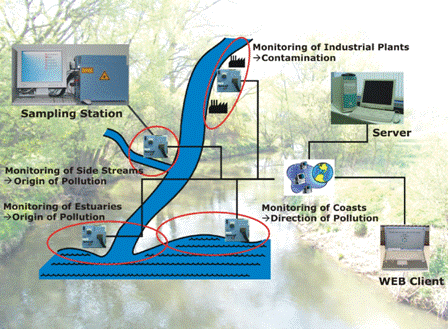Environmental Monitoring
NANOS4![]() (Nanostructured Solid-state Gas Sensors with Superior Performance) deals with the application of microtechnologies and nanotechnologies to develop gas sensors with improved sensitivity for air quality monitoring. Solid state gas sensors based on nanostructured metal oxides can provide faster response with real-time analysis, higher spatial resolution, simplified operation and lower running costs compared with conventional monitoring systems. The sensing mechanism depends on the measurement of changes in electrical resistivity due to gas molecules adsorbed on the surface of the oxide layer. Toxic gases such as carbon monoxide and nitrogen dioxide can be detected at concentrations lower than the existing EU legal limits. Advanced materials engineering techniques such as vapour phase transport crystal growth are used to produce different metal oxides in the form of thin nanowires and nanobelts to increase the surface area exposed to the air and thus increase the sensitivity. These nanostructured metal oxides will be used for fabricating the next generation of selective and stable gas sensors.
(Nanostructured Solid-state Gas Sensors with Superior Performance) deals with the application of microtechnologies and nanotechnologies to develop gas sensors with improved sensitivity for air quality monitoring. Solid state gas sensors based on nanostructured metal oxides can provide faster response with real-time analysis, higher spatial resolution, simplified operation and lower running costs compared with conventional monitoring systems. The sensing mechanism depends on the measurement of changes in electrical resistivity due to gas molecules adsorbed on the surface of the oxide layer. Toxic gases such as carbon monoxide and nitrogen dioxide can be detected at concentrations lower than the existing EU legal limits. Advanced materials engineering techniques such as vapour phase transport crystal growth are used to produce different metal oxides in the form of thin nanowires and nanobelts to increase the surface area exposed to the air and thus increase the sensitivity. These nanostructured metal oxides will be used for fabricating the next generation of selective and stable gas sensors.

Metal oxide nanobelts grown by the vapor transport and condensation technique.
(A. Vomiero, University of Brescia)
AWACSS![]() (Automated Water Analyser Computer Supported System) is a remote water monitoring station that uses miniaturised biosensors to obtain real-time data on levels of pollutants, such as pesticides, antibiotics, natural toxins, carcinogens and industrial waste, and transmit them to a central computer. It provides a fast, sensitive, cost effective, and easy to use analytical system that is able to measure organic compounds down to below nanogram per litre levels. An integrated optical immunoassay chip can detect and provide information on up to thirty-two different compounds in less than twenty minutes. No prior sample treatment is needed other than filtration to remove particulate matter. The minimum detection limits are lower than the EU recommended safe levels for many priority substances and the chip can be reused up to five hundred times before it needs to be replaced.
(Automated Water Analyser Computer Supported System) is a remote water monitoring station that uses miniaturised biosensors to obtain real-time data on levels of pollutants, such as pesticides, antibiotics, natural toxins, carcinogens and industrial waste, and transmit them to a central computer. It provides a fast, sensitive, cost effective, and easy to use analytical system that is able to measure organic compounds down to below nanogram per litre levels. An integrated optical immunoassay chip can detect and provide information on up to thirty-two different compounds in less than twenty minutes. No prior sample treatment is needed other than filtration to remove particulate matter. The minimum detection limits are lower than the EU recommended safe levels for many priority substances and the chip can be reused up to five hundred times before it needs to be replaced.

Biosensor network for on-line, unattended and centrally controlled water monitoring and surveillance.
(G. Proll, University of Tuebingen)